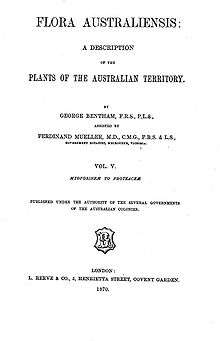Bentham's taxonomic arrangement of Dryandra

George Bentham's taxonomic arrangement of Dryandra (now B. ser. Dryandra) was published in 1870, in Volume 5 of Bentham's Flora Australiensis.[1] It replaced the 1856 arrangement of Carl Meissner, and stood for over a century before being replaced by the 1996 arrangement of Alex George.
Background
The dryandras are a group of proteaceous shrubs endemic to southwest Western Australia. For nearly two hundred years they were considered a separate genus, having been published at that rank in 1810 by Robert Brown. In 2007 it was transferred into the genus Banksia as B. ser. Dryandra. There are now just under 100 species, plus numerous subspecies and varieties.
The first infrageneric arrangement of Dryandra was Brown's 1810 arrangement, which listed 13 species, but did not attempt an infrageneric classification.[2] Twenty years later, Brown published a revised arrangement which divided 23 recognised species in three subgenera, and placed one further species in a separate genus Hemiclidia.[3] This was followed by the 1856 arrangement of Carl Meissner, which recognised 53 species and six varieties, dividing them into three sections and eight series, and maintaining the monospecific genus Hemiclidia.[4][5]
Bentham's arrangement
Bentham's arrangement was published in 1870, in Volume V of Flora Australiensis. He reduced the number of species to 47, and the number of varieties to two, proposing an arrangement consisting of two sections and seven series. Hemiclidia was transferred back into Dryandra.[1]
George Bentham's 1870 taxonomic arrangement of Dryandra may be summarised as follows:[1]
- Genus Dryandra (now Banksia ser. Dryandra)
- Section Eudryandra
- Series Armatæ
- D. quercifolia (now B. heliantha)
- D. praemorsa (now B. undata)
- D. cuneata (now B. obovata)
- D. falcata (now B. falcata)
- D. armata (now B. armata)
- D. longifolia (now B. prolata)
- D. Fraseri (now B. fraseri)
- Series Floribundæ
- D. floribunda (now B. sessilis var. sessilis)
- D. floribunda var. major (now B. sessilis var. cordata)
- D. carduacea (now B. squarrosa subsp. squarrosa)
- D. carlinoides (now B. carlinoides)
- D. polycephala (now B. polycephala)
- D. Kippistiana (now B. kippistiana)
- D. floribunda (now B. sessilis var. sessilis)
- Series Concinnæ
- D. squarrosa (now B. squarrosa)
- D. serra (now B. serra)
- D. concinna (now B. concinna)
- D. foliolata (now B. foliolata)
- Series Formosæ
- D. stupposa (now B. stuposa)
- D. nobilis (now B. nobilis)
- D. mucronulata (now B. mucronulata)
- D. formosa (now B. formosa)
- D. Baxteri (now B. biterax)
- Series Niveæ
- D. nivea (now B. nivea)
- D. arctotidis (now B. arctotidis)
- D. arctotidis var. tortifolia (now B. tortifolia)
- D. nana (now B. nana)
- D. Preissii (now B. acuminata)
- Series Obvallatæ
- D. sclerophylla (now B. sclerophylla)
- D. pulchella (now B. bella)
- D. plumosa (now B. plumosa)
- D. seneciifolia (now B. seneciifolia)
- D. vestita (now B. vestita)
- D. cirsioides (now B. cirsioides)
- D. Hewardiana (now B. hewardiana)
- D. patens (now B. hewardiana)
- D. conferta (now B. densa)
- D. horrida (now B. horrida)
- D. serratuloides (now B. serratuloides)
- D. comosa (now B. comosa)
- Series Gymnocephalæ
- D. Shuttleworthiana (now B. shuttleworthiana)
- D. speciosa (now B. splendida)
- D. tridentata (now B. tridentata)
- Series Armatæ
- Section Aphragma
- D. tenuifolia (now B. tenuis)
- D. proteoides (now B. proteoides)
- D. proteoides var. ferruginea (now B. rufa
- D. runcinata (now B. r. subsp. rufa)
- D. obtusa (now B. obtusa)
- D. bipinnatifida (now B. bipinnatifida)
- D. pteridifolia (now B. pteridifolia)
- D. calophylla (now B. calophylla)
- Section Eudryandra
Legacy
Bentham's arrangement remained the accepted arrangement of Dryandra 126 years. It was finally replaced in 1996 by a new arrangement published by Alex George. George's arrangement retained a number of Bentham's infrageneric taxa.[6]
In 2007, Austin Mast and Kevin Thiele transferred Dryandra into Banksia, on the grounds that Banksia was paraphyletic with respect to Dryandra. Mast and Thiele were not yet ready to proffer an arrangement for the new circumscription of Banksia, so as an interim measure they transferred Dryandra at series rank, so as to minimise disruption to the nomenclature. Thus the infrageneric arrangement of Dryandra has been set aside, at least temporarily, and hence none of Bentham's infrageneric taxa are in current use.[7]
References
| Wikisource has original text related to this article: |
- 1 2 3 Bentham, George (1870). "Dryandra". Flora Australiensis. Volume 5: Myoporineae to Proteaceae. London: L. Reeve & Co. pp. 562–584.
- ↑ Brown, Robert (1810). Prodromus Florae Novae Hollandiae et Insulae Van Diemen. London: Taylor.
- ↑ Brown, Robert (1830). Supplementum Primum Prodromi Florae Novae Hollandiae. London: Taylor. pp. 37–40.
- ↑ Meissner, Carl (1856). "XLIV. Dryandra". In de Candolle, A. P. Prodromus systematis naturalis regni vegetabilis. XIV. Paris: Sumptibus Sociorum Treuttel et Wurtz. pp. 467–481.
- ↑ Meissner, Carl (1856). "XLV. Hemiclidia". In de Candolle, A. P. Prodromus systematis naturalis regni vegetabilis. XIV. Paris: Sumptibus Sociorum Treuttel et Wurtz. pp. 481–482.
- ↑ George, Alex S. (1996). "New taxa and a new infragenetic classification in Dryandra R.Br. (Proteaceae: Grevilleoideae)". Nuytsia. 10 (3): 313–408.
- ↑ Mast, A. R. and Kevin Thiele (2007). "The transfer of Dryandra R.Br. to Banksia L.f. (Proteaceae)". Australian Systematic Botany. 20: 63–71. doi:10.1071/SB06016.